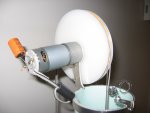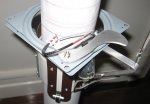inglewoodpete
Senior Member
For the last 7 months, I have been part of a team developing a robotic art display called "Silent Barrage". PICAXE 28x1s form the core of the networking and control of the display in the gallery.
In as simple terms as possible, the display centres on a network of embryonic rat neurons grown in-vitro at the Georgia Institute of Technology. The robotic body, forming the display and premiering at Exit Art Gallery, New York, is an array of 36 networked objects communicating with the neurons.
The display is an array of 36 objects or 'poles', each 2.75 metres tall, arranged in a 6 x 6 matrix and spaced about 1 metre apart. Each pole has a print head that is raised and lowered along the height of the pole, the position determined by the neurons. When the print head reaches its required position, a line is drawn on paper wrapped around the pole by a second motor. The PICAXE on each pole takes its instructions from a master controller, also a 28x1, via an extended i2c bus.
The master controller is connected via its hSerial port to a PC interfacing to a VPN on the internet. The internet then completes the link to the neurons.
Finally, feedback to stimulate the neurons is provided via an array of cameras interfacing with custom made software to produce a low resolution digital 'image'. These cameras are mounted above the gallery display and capture images of the viewing public as they walk among the matrix of poles. The digital images generated from the cameras stimulate the neurons, and electrodes monitor the neuron's response. The responses from the neurons are then transmitted every few seconds to the PC located at the gallery and then on to the PICAXEs on the display.
As mentioned previously, each pole has its own PICAXE microcontroller waiting for instructions via i2c. Internally, the pole contains a counterweight to balance the print head. The counterbalance has a 'wiper' that contacts a nichrome wire tensioned between the top and bottom of the pole, acting as a potentiometer. The PICAXE then uses PWM and custom developed pulsing of the height motor, together with 10-bit ADC feedback from the nichrome wire, to position the head. This method has given an accuracy of better than 4mm or about 0.2%. Once the head has reached the correct position, the PICAXE then operates a pen motor which spins around the pole, marking a line. Once the cycle is complete, the pole PICAXE then sets its status as 'idle'. The master microcontroller polls each 'slave' PICAXE via i2c during this positioning process, waiting for all poles to complete their positioning task. In the meantime the controlling PC has requested and received a fresh set of coordinates from the neurons, ready to download to the PICAXEs.
In order to meet the stringent criteria, and due to variations in the characteristics of the individual hand-made poles, each pole enters a 'learning' phase when it boots for the first time on a new software revision. The learning phase for each pole puts the print head through a series of measured tests, with the results written into EEPROM in the PICAXE. This then gives each pole controller its own 'personality' to allow the fastest and most accurate positioning of the print head. The 'learning' phase takes 3 to 4 minutes and the data is then available from EEPROM on subsequent reboots of the pole boards.
The project is the brainchild of artists Guy Ben-Ary and Philip Gamblen from Perth, Western Australia. Microcontroller PCBs were designed and assembled by Dr Nathan Scott. Video feedback development was provided by Brett Murray. I designed, developed and tested the PICAXE software. Work on the project, for the greater part, has been voluntary. The project has been supported through the University of Western Australia and the Australia Council for the Arts. The biological "brain" or neural network was developed by Dr Steve Potter's lab in Altanta, Georgia. "Silent Barrage" forms part of the "Corpus Extremus (LIFE+)" exhibition at the Exit Art Gallery New York which opens this evening, 28th February 2009.
I'd also like to acknowledge the support provided by Revolution Education to overcome firmware difficulties we encountered during development. Also, thanks to the assistance and discussion from many forum members when we posted problems with i2c, PWM and motor interference.
Peter Gee
"inglewoodpete"
In as simple terms as possible, the display centres on a network of embryonic rat neurons grown in-vitro at the Georgia Institute of Technology. The robotic body, forming the display and premiering at Exit Art Gallery, New York, is an array of 36 networked objects communicating with the neurons.
The display is an array of 36 objects or 'poles', each 2.75 metres tall, arranged in a 6 x 6 matrix and spaced about 1 metre apart. Each pole has a print head that is raised and lowered along the height of the pole, the position determined by the neurons. When the print head reaches its required position, a line is drawn on paper wrapped around the pole by a second motor. The PICAXE on each pole takes its instructions from a master controller, also a 28x1, via an extended i2c bus.
The master controller is connected via its hSerial port to a PC interfacing to a VPN on the internet. The internet then completes the link to the neurons.
Finally, feedback to stimulate the neurons is provided via an array of cameras interfacing with custom made software to produce a low resolution digital 'image'. These cameras are mounted above the gallery display and capture images of the viewing public as they walk among the matrix of poles. The digital images generated from the cameras stimulate the neurons, and electrodes monitor the neuron's response. The responses from the neurons are then transmitted every few seconds to the PC located at the gallery and then on to the PICAXEs on the display.
As mentioned previously, each pole has its own PICAXE microcontroller waiting for instructions via i2c. Internally, the pole contains a counterweight to balance the print head. The counterbalance has a 'wiper' that contacts a nichrome wire tensioned between the top and bottom of the pole, acting as a potentiometer. The PICAXE then uses PWM and custom developed pulsing of the height motor, together with 10-bit ADC feedback from the nichrome wire, to position the head. This method has given an accuracy of better than 4mm or about 0.2%. Once the head has reached the correct position, the PICAXE then operates a pen motor which spins around the pole, marking a line. Once the cycle is complete, the pole PICAXE then sets its status as 'idle'. The master microcontroller polls each 'slave' PICAXE via i2c during this positioning process, waiting for all poles to complete their positioning task. In the meantime the controlling PC has requested and received a fresh set of coordinates from the neurons, ready to download to the PICAXEs.
In order to meet the stringent criteria, and due to variations in the characteristics of the individual hand-made poles, each pole enters a 'learning' phase when it boots for the first time on a new software revision. The learning phase for each pole puts the print head through a series of measured tests, with the results written into EEPROM in the PICAXE. This then gives each pole controller its own 'personality' to allow the fastest and most accurate positioning of the print head. The 'learning' phase takes 3 to 4 minutes and the data is then available from EEPROM on subsequent reboots of the pole boards.
The project is the brainchild of artists Guy Ben-Ary and Philip Gamblen from Perth, Western Australia. Microcontroller PCBs were designed and assembled by Dr Nathan Scott. Video feedback development was provided by Brett Murray. I designed, developed and tested the PICAXE software. Work on the project, for the greater part, has been voluntary. The project has been supported through the University of Western Australia and the Australia Council for the Arts. The biological "brain" or neural network was developed by Dr Steve Potter's lab in Altanta, Georgia. "Silent Barrage" forms part of the "Corpus Extremus (LIFE+)" exhibition at the Exit Art Gallery New York which opens this evening, 28th February 2009.
I'd also like to acknowledge the support provided by Revolution Education to overcome firmware difficulties we encountered during development. Also, thanks to the assistance and discussion from many forum members when we posted problems with i2c, PWM and motor interference.
Peter Gee
"inglewoodpete"


